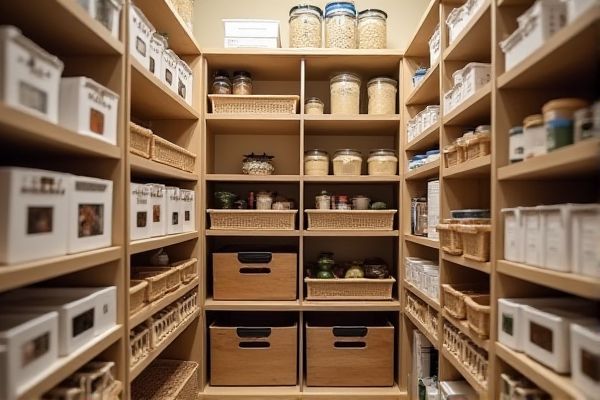
Dry goods bins provide airtight storage that preserves freshness and prevents pests, while open baskets offer easy access and better visibility for frequently used items. Discover which storage solution suits Your pantry needs best by exploring the rest of the article.
Table of Comparison
| Feature | Dry Goods Bins | Open Baskets |
|---|---|---|
| Protection | Sealed, keeps dry goods fresh and pests out | Open, exposes contents to air and pests |
| Organization | Stackable, labeled for neat storage | Less structured, items visible but mixed |
| Visibility | Opaque or clear containers; easy content view if clear | Fully visible, quick item identification |
| Space Efficiency | Compact, maximizes pantry space | Variable, may take more space due to open design |
| Maintenance | Easy to clean, prevents spills | Requires frequent cleaning, prone to dust |
| Cost | Generally higher investment | Typically lower cost option |
Introduction to Pantry Storage: Bins vs. Baskets
Dry goods bins provide airtight, stackable storage solutions that preserve freshness and optimize space in a pantry, ideal for items like flour, sugar, and grains. Open baskets offer easy access and visibility, making them suitable for frequently used snacks and produce but may compromise on freshness and organization. Choosing between bins and baskets depends on balancing accessibility with preservation needs in pantry management.
Defining Dry Goods Bins and Open Baskets
Dry goods bins are airtight containers designed to preserve the freshness of pantry staples like flour, sugar, grains, and cereals by preventing moisture and pests from entering. Open baskets, typically made of woven materials such as wicker or wire, provide easy access and visibility for storing fruits, vegetables, or packaged items but lack the sealing properties needed for long-term dry goods preservation. Choosing between dry goods bins and open baskets depends on the priority of maintaining food freshness versus ease of access and aesthetic appeal in pantry organization.
Organization and Space Efficiency
Dry goods bins offer superior organization by categorizing items with airtight seals that maintain freshness while maximizing vertical space through stackability. Open baskets provide easy visibility and quick access but often sacrifice space efficiency since they cannot be securely stacked or sealed. Your pantry benefits most from a combination, using bins for bulk storage and baskets for frequently used items to optimize both organization and space.
Accessibility and Convenience
Dry goods bins provide sealed storage that enhances food freshness while allowing stackable organization for easy space optimization. Open baskets offer immediate visibility and quick access to pantry items, making grab-and-go retrieval effortless without lifting lids. Choosing between bins and baskets depends on balancing airtight protection against the need for rapid item identification and accessibility.
Food Preservation and Freshness
Dry goods bins offer airtight seals that significantly improve food preservation by preventing moisture, pests, and air exposure, thereby extending the freshness of pantry staples like flour, rice, and beans. Open baskets, while providing easy access and ventilation, expose contents to humidity and contaminants, which can accelerate spoilage and reduce shelf life. Choosing dry goods bins enhances longevity and maintains optimal texture and flavor compared to open baskets in pantry storage.
Visibility and Inventory Management
Dry goods bins provide superior visibility by featuring clear sides or labels that allow easy identification of contents, reducing the risk of forgotten items. These airtight containers help maintain freshness while enabling precise inventory tracking, minimizing food waste and over-purchasing. In contrast, open baskets offer less visibility, causing items to blend together, which can complicate inventory management and increase the likelihood of overlooked or expired pantry staples.
Cleaning and Maintenance
Dry goods bins offer superior protection against dust, moisture, and pests, making them easier to clean and maintain compared to open baskets in a pantry. Their airtight lids prevent food contamination and reduce spills, requiring only occasional wiping of the exterior and interior surfaces. Open baskets accumulate dust and crumbs quickly, necessitating more frequent cleaning and vigilance to maintain pantry hygiene.
Aesthetic Appeal and Pantry Styling
Dry goods bins elevate pantry styling by offering a sleek, uniform look that conceals clutter and enhances aesthetic appeal. Open baskets introduce a rustic, casual vibe, allowing easy visibility and access to items while adding texture and warmth to your pantry space. Your choice influences the overall pantry ambiance, balancing between streamlined sophistication and inviting charm.
Cost Comparison: Bins vs. Baskets
Dry goods bins typically offer a higher upfront cost compared to open baskets, but their airtight seals provide better food preservation, potentially reducing waste and saving money long-term. Open baskets tend to be more budget-friendly initially, though they lack moisture protection, which may lead to more frequent product replacement. Investing in bins can be more cost-effective over time for maintaining pantry freshness and minimizing spoilage expenses.
Choosing the Best Storage Option for Your Pantry
Dry goods bins provide airtight protection that preserves freshness and prevents pests, making them ideal for long-term storage of grains, flour, and cereals. Open baskets offer easy access and visibility, perfect for frequently used items like snacks or produce, but lack moisture control. Selecting between bins and baskets depends on the balance between preservation needs and accessibility in your pantry organization.
 homyna.com
homyna.com